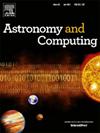xmm -牛顿和INTEGRAL作战地面部分:协同系统和软件已经运行了20多年
IF 1.8
4区 物理与天体物理
Q2 ASTRONOMY & ASTROPHYSICS
引用次数: 0
摘要
欧洲航天局(ESA)已经运行xmm -牛顿和INTEGRAL天文台超过20年,提供了宝贵的高能天体物理数据。两个任务共享一个协同操作地面部分,允许简化任务控制、自动化增强和优化资源利用。本文讨论了任务控制系统的发展,航天器和仪器操作自动化的集成,以及采用虚拟化技术来确保任务的长期可持续性。此外,它还强调了在最小化运营成本的同时维持实时遥测驱动的操作所面临的挑战。从这些任务中吸取的经验教训为欧空局未来的科学行动提供了关键的见解。这项工作强调的一个关键成果是长期成功地保留了传统的soc -2000系统,尽管硬件和软件环境不断发展,该系统已经可靠地运行了20多年。本文章由计算机程序翻译,如有差异,请以英文原文为准。
The XMM-Newton and INTEGRAL operational ground segment: Synergetic systems and software operated for more than two decades
The European Space Agency (ESA) has been operating the XMM-Newton and INTEGRAL observatories for over two decades, providing invaluable high-energy astrophysical data. Both missions share a synergistic operational ground segment, allowing for streamlined mission control, automation enhancements, and optimized resource utilization. This paper discusses the evolution of the mission control system, the integration of automation for spacecraft and instrument operations, and the adoption of virtualization technologies to ensure long-term mission sustainability. Additionally, it highlights the challenges of maintaining real-time telemetry-driven operations while minimizing operational costs. Lessons learned from these missions provide key insights for future ESA science operations. A key outcome highlighted in this work is the long-term success of retaining the legacy SOCS-2000 system, which has reliably operated for over two decades despite evolving hardware and software environments.
求助全文
通过发布文献求助,成功后即可免费获取论文全文。
去求助
来源期刊

Astronomy and Computing
ASTRONOMY & ASTROPHYSICSCOMPUTER SCIENCE,-COMPUTER SCIENCE, INTERDISCIPLINARY APPLICATIONS
CiteScore
4.10
自引率
8.00%
发文量
67
期刊介绍:
Astronomy and Computing is a peer-reviewed journal that focuses on the broad area between astronomy, computer science and information technology. The journal aims to publish the work of scientists and (software) engineers in all aspects of astronomical computing, including the collection, analysis, reduction, visualisation, preservation and dissemination of data, and the development of astronomical software and simulations. The journal covers applications for academic computer science techniques to astronomy, as well as novel applications of information technologies within astronomy.
 求助内容:
求助内容: 应助结果提醒方式:
应助结果提醒方式:


